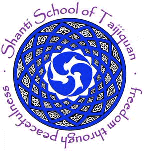WELCOME
- SUSAN A MATTHEWS HOME
- SHANTI SCHOOL HOME PAGE
- STUDY GUIDE
- SPIRAL ANATOMY™
- BRAIN WORKSHOP™ TRAINING
- GEORGE XU HOME PAGE
- CONTACT US
Website
Design: Susan Matthews
© 2003-2025
all rights reserved
No part of this website may be reproduced without expressed permission.
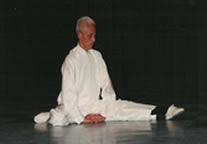
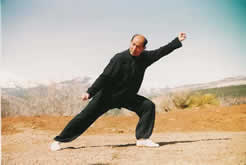 Fundamental Practices: Power Stretching
Fundamental Practices: Power Stretching
©2013-2022 Susan Matthews
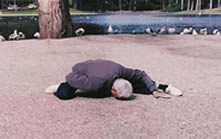 Please sign up for email updates!
Please sign up for email updates!
Power stretching is an integral part of the martial arts practice of an internal fighting style called Lan Shou Quan. Any practitioner of Chinese Internal Martial Arts who studies long enough and consistently will eventually arrive at a point of learning some form of power stretching exercises. My understanding of power stretch comes through Lan Shou Masters George Xu, Wu Ji and Ye Xiao Long, as well as Wang Ming Bo and Shou Guan Shun. These masters are from Shanghai. Most study several forms of internal arts and consider power stretching essential for whole-body or one-unit connected, loose, relaxed, spiraling power in all styles. Power stretching is an amazing gift from the Lan Shou System. Listed below are recommended titles that include power stretching. Read the full chapter below about Power Stretching and why it should be included in your practice...
 Spiral Anatomy™ Module 3 is a great package that includes many of these videos. Module 3 provides stepwise training on power stretching!
Spiral Anatomy™ Module 3 is a great package that includes many of these videos. Module 3 provides stepwise training on power stretching!
Module 3 - Power Stretching Collection: Best videos in one package. Order/Download only $39.95
Module 3 Contents:
1. Susan Matthews Lan Shou Power Stretching Introduction to Module 3 (PDF)
2. Master YE XIAO LONG Power Stretch 1 (3:37)
3. Master WU JI Power Stretching First Section (3:10)
4. Susan Matthews Opening the Low Back (4:50)
5. 'Dont Let Me Lift Your Arm' Test (0:56)
6. Susan Matthews Power Stretch Exercise(8:13)
7.
Master YE XIAO LONG Power Stretch 2 (10.53)
8. Master GEORGE XU Spiraling Power Stretching (21:22)
9. Master WU JI Lan Shou Muscle-Tendon Stretching Exercises (35:27)
10. Double Dragon VOL 3 Master SHOU GUAN SHUN Jin Shin Ba Gu (1:16:30)
11. Master WANG MING BO Jin Shin Ba Gu (1:12:47)
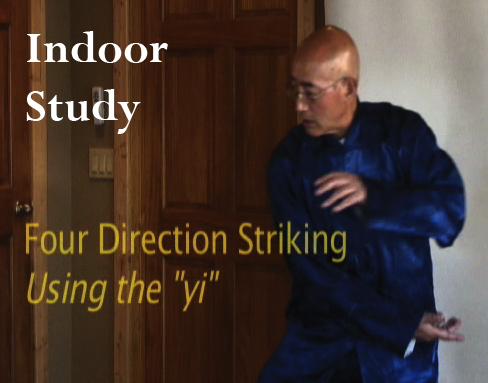 Four Important Things- Indoor Study with Master George Xu
Four Important Things- Indoor Study with Master George Xu
Indoor Study introduces important information for developing power in martial arts. First George focuses on a series of exercises to develop one of the most important skills for martial power he calls three dimensional shrinking /expanding with the energy body. Next, he presents several unique power stretching postures that circle and spiral and, some in particular, develop leg power. Power stretch is important to develop whole-body connectivity. Once the body is connected, the body can use chan shi chin, or spiraling, to move in three dimensions, effectively reducing the enemy's force to zero. George presents several spiral training exercises also containing shrink/expand quality and the fourth important quality that is center (dantian) energy moving first. Several multidirectional dynamic exercises are presented for developing dantian gong. Master Xu finishes with qigong for gathering earth power, human power, and heaven power and a cool demonstration of four direction striking using all these qualities. This video complements the discussion and applications of these moves found in Master Xu’s Complete Practice. Indoor Study is nearly 40 minutes non-stop workout/practice. $24.95
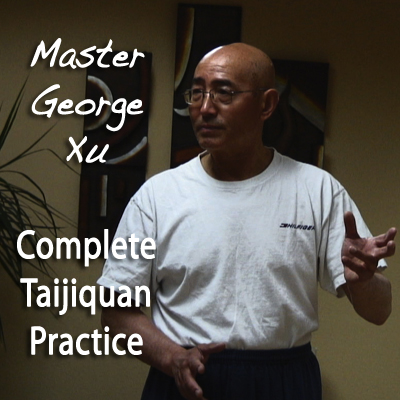 Master George
Xu Complete Practice: Dantien Gong, Power Stretching, and Spiral Training is the perfect training set to practice every day with George. Follow
along as he demonstrates and discusses four essential components of taijiquan
and all internal arts: Dantien Gong, Power Stretching, Spiral Training
and Shrink/Expand. Dantien gong (8 moves), shrinking-expanding moves (8),
power stretching postures (8), and Chan-shi-jing (10 spiraling postures).
These are crucial practices to be aware of whether utilized for longevity
or martial application.
Master George
Xu Complete Practice: Dantien Gong, Power Stretching, and Spiral Training is the perfect training set to practice every day with George. Follow
along as he demonstrates and discusses four essential components of taijiquan
and all internal arts: Dantien Gong, Power Stretching, Spiral Training
and Shrink/Expand. Dantien gong (8 moves), shrinking-expanding moves (8),
power stretching postures (8), and Chan-shi-jing (10 spiraling postures).
These are crucial practices to be aware of whether utilized for longevity
or martial application.
Master Xu is true to the authentic ancient knowledge that has been passed down through the ages. He is both traditional and modern in his practice and perspectives. Listen to him elucidate his unique perspective on the art of internal movement and the importance of understanding being connected as a single unit, moving the dantian like a predator, and spiraling for power and ability.
A special feature of this video is of Master Xu demonstrating spiral technique in the Bagua Zhang form and Chen Style Taijiquan form.
Detailed sessions videotaped during a weekend workshop in Cortez, Colorado, hosted by Susan A. Matthews. Some subtitles are included. Two hours ©2011 M014- $39.90
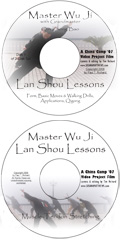 Master
Wu Ji Lan Shou Lessons, with Grandmaster Qin Zhong Bao. Two-Volume
set.
Master
Wu Ji Lan Shou Lessons, with Grandmaster Qin Zhong Bao. Two-Volume
set.
Part One includes a demonstration of the cao quan section of the Lan Shou form, basic move drills, including walking drills, application demonstrations, and a few standing qigong exercises with Grandmaster Qin. English translation by Poh Kheng Loi and David Leung. 69 minutes.
Part Two: Master Wu Ji Lan Shou Muscle-Tendon Stretching Exercises. This 35-minute video is a review of stretching exercises that Master Wu Ji taught as part of the Lan Shou system training during China Camp '07. The exercises are grouped together for easy follow-along learning. Translated by Poh Kheng Loi. Length-35:27 min. Two-videos: $39.95.
Master Ye Xiao Long the King of Power Stretching
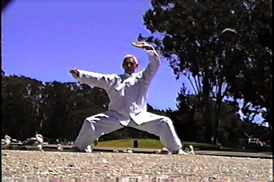 Master Ye Xiao Long Power Stretching Postures
Master Ye Xiao Long Power Stretching Postures
Ye Xiao Long demonstrates amazing flexibility as a result of practicing power stretching. Many many hip and leg stretch postures are demonstrated. Master Ye also demonstrates Yang Style Form. Master Ye's thin frame belies his considerable bone-tendon-ligament power developed from power stretching. This arclhival footage came from Master George Xu Library. 10:53 min. This Volume is included in Spiral Anatomy™
Module 3 - Power Stretching Collection: Best videos in one package. Order/Download only $39.95
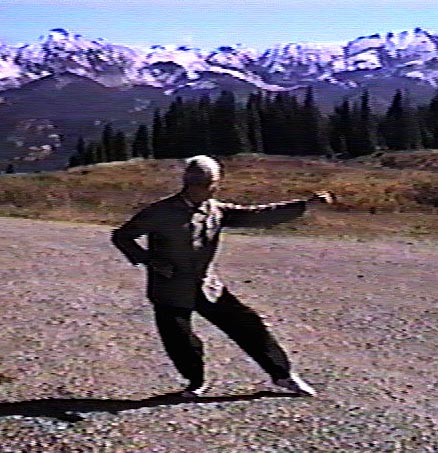 Ye Xiao Long and George Xu Workshop: Lan Shou and Power Stretching Essentials Telluride 1998
Ye Xiao Long and George Xu Workshop: Lan Shou and Power Stretching Essentials Telluride 1998
Lan Shou Quan Essentials with Ye Xiao Long and George Xu documents the Power Stretching and Lan Shou Workshop in Telluride, Colorado, 1998. Video has rare footage of Ye Xiao Long. Both Chen and Lan Shou forms are practiced as well as two person drills and push hands where power stretching and the value of greater range of motion through power stretching is emphasized. Great footage of Master Ye Archival footage, digitized from VHS so some quality is lost. 40 min. $19.95
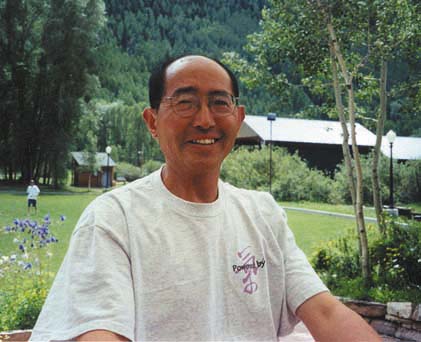
George Xu's Nine Categories of Training covers many single basic movements that form a powerful foundation for overall taiji training. In his usual approach, Master Xu leads Telluride, Colorado weekend workshop participants in doing the very moves he does himself to train. This August 1997 vintage footage on VHS, digitized into digital format, is a fairly early representation of Master Xu's approach to workshop training. He shows moves that he no longer does, and many he continues this day to do. This is a good video for young trainees to see his more physical training approach of that time. If you're interested in well-focused physical, nearly two-hour training experience, this video will be a good one to use to follow along with Master Xu as he leads workshop participants. Nowadays, Master Xu moves much more energetically and with what he calls “spiritual” awareness. If you are interested in how Master Xu has evolved over the past 15 years or more, this footage will be of interest to you. You get the added benefit of an excellent training experience that encompasses many practices that he has offered through the years including: hun yuan qigong, spiral training (chan shi jin), power stretching, some Chen form, and sitting qi circles. 1hr 52min $34.95
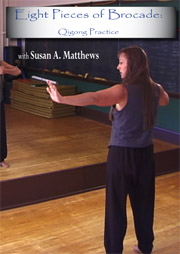 Eight
Pieces of Brocade Qigong with Susan Matthews
Eight
Pieces of Brocade Qigong with Susan Matthews
Eight Pieces of Brocade is one of the oldest known forms of qigong ("CHEE gong") that originated in China some 800 years ago. Qigong means to cultivate energy over a long period of time and has been shown to improve overall health and feelings of well-being. It is ideal for beginner tai chi and qigong practitioners. The postures are simple to learn, but doing them correctly for their fullest benefits is key to feeling their profound effects in moving energy in the major meridians. Practice regularly and mindfully and you will unravel the secret. While this is a simple qigong set, Susan provides advanced information for setting up opposing anatomical forces.
The Eight Pieces of Brocade is in two parts. Part I is the entire sequence practiced to calming music. Part II is presented with detailed instructions for transmitting spirals both softly and with power. The first way is taught describing the anatomical details of power-stretching in which one part of the body is set up in opposition to another, creating an isometric stretch around the joints. This requires understanding how to set up ground force. The second way describes the same movements with soft, relaxed qi. 27 min. ©2002, 2006
Eight Pieces of Brocade is fully contained within Spiral Anatomy Module 2.
Module 2 - Balance plus Brain Workshop™ Collection: Best videos in one package. Order/Download only $39.95
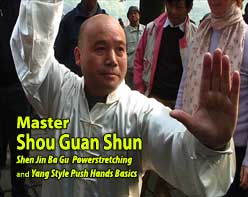 VOL
3 Master Shou Guan Shun on
Shin Jin Ba Gu and Push Hands Internal Principles
VOL
3 Master Shou Guan Shun on
Shin Jin Ba Gu and Push Hands Internal Principles
Lessons on the 'Power Shield.'
Shou
Guan Shun (Yang Style) Shin Jin Ba Gu Stretching and Yang Style
Push Hands Basics
Shin Jin Ba Gu is a Lan Shou style power stretching set. It helps
to build good physical structure while releasing trapped qi. A
very good complement to what Master Liu Hong Cai says about the
need to have correct physical structure as well as energy alignment.
Master Shou talks about filling the body with qi. The tips of
the fingers are flush, even pudgy, with qi. In push hands he pushes
blindfolded to demonstrate how to sense the other person's movement
with the body, not look with the eyes only. He also works with
participants in Da Lu, or walking push hands. 1hr 15 min. This Volume is included in Spiral Anatomy™ Module 3.
Module 3 - Power Stretching Collection: Best videos in one package. Order/Download only $39.95
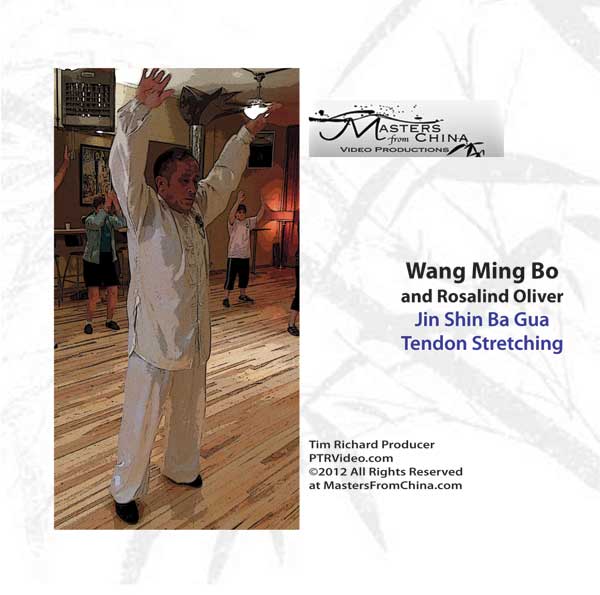 Shin Jin Ba Gu, Tendon Stretching and Follow Up Lecture with Wang Ming Bo and Rosalind Oliver
Shin Jin Ba Gu, Tendon Stretching and Follow Up Lecture with Wang Ming Bo and Rosalind Oliver
Power stretching is an integral part of martial arts practice, such as Shaolin Gongfu and Lan Shou Quan. Tendon and bone stretching set is a very effective method of strengthening the connective tissues of the body as well as bones and joints. It is simple set of specific postures each of which incorporates an intensive stretching then relaxing then stretching regimen. You can perform Shin Jin Ba Gu as strenuously as necessary, but to seek and reach for your limits is essential in achieving this exercise's greatest benefits. An excellent lecture and discussion follows on the principle and usage of the 13 potential energies or forces in Taiji, Xing-yi and other internal martial arts (peng,lu, ji, an, shou, zhong, etc.). Wang and Ms. Oliver demonstrate the importance of training for maximum extension of the body, integrate that with yin-yang in push hands (Tui Shou), and demonstrate its application as a powerful technique for moving an opponent. 1.25 hr. This Volume is included in Spiral Anatomy™ Module 3.
Module 3 - Power Stretching Collection: Best videos in one package. Order/Download only $39.95
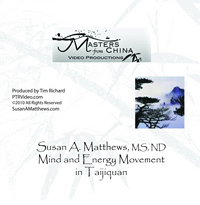 Mind and Energy Movement in Taijiquan
Mind and Energy Movement in Taijiquan
Susan Matthews presents instruction ranging from detailed techniques to overarching concepts on the biomechanics of key movement principles of taijiquan, such as zhong ding, dantian, open and close, and spiral anatomy. She describes and demonstrates techniques, and leads workshop participants in simple, single movements common in taiji practice.
In
her unique trademark
approach, Shifu Matthews integrates neuroscience and her extensive knowledge
of anatomy with using mind intention and energetic awareness to move the
body. This is the essence of which distinguishes taijiquan from other
forms of martial arts, as well as other forms of exercise. She also incorporates
pieces in her training from other Chinese internal martial arts styles,
including xing-yi quan and lan shou quan. She also brings into the equation
her practice of medical qigong as well as a section of guided visualization
and meditation practice.
This video contains information useful for beginners and beyond. More advanced
practitioners will hear new information as well as familiar concepts presented
in a fresh and unique manner. Higher level practitioners will be pleased
with the fresh approach her unique teaching approach brings.
She details each concept then leads the group to incorporate them in simple
exercises. This 90-minutes (plus 25 min. extras) filmed in Telluride,
Colorado in August 2010 comes with an additional several minutes of extras
adding to the wealth of information Matthews has shared in several previous
video releases. ©2011 $39.95.
Power Stretching
Excerpted from Spiral Anatomy by Susan A. Matthews, MS, ND, Serai Communication Arts, Pub. ©2003, 2022
Power stretching is part of basic training in the Lan Shou System, an internal style of fighting characterized by its side-power technique. Any practitioner of Chinese Internal Martial Arts who studies long enough and consistently will eventually arrive at a point of learning some form of power stretching exercises that tones the body. Just like spiral training specifically trains for spiraling biomechanics in Chen Style (chan shi chin), power stretching specifically prepares the bone, tendon, ligament for whole-body connection, one-unit movement in chan shi chin.This is what I have learned from my teachers Lan Shou Masters George Xu, Wu Ji and Ye Xiao Long, as well as Wang Ming Bo and Shou Guan Shun. These masters are from Shanghai. Most study several forms of internal arts and consider power stretching essential for whole-body or one-unit connected, loose, relaxed, spiraling power in all styles. Power stretching is an amazing gift from the Lan Shou System. This is my way of describing how I understand power stretch using my education and experience in anatomy, biomechanics, and neuroscience combined with 30 years training in Chinese Internal Martial Arts. This method works well to create a strong root, great balance, and formidable power. References and sources of this information is recorded on the videos referenced on this web page.
Introduction
Power stretching is mostly a physical practice, meaning one focuses on what the muscles, joints, skeletal structure is doing. Strength is felt in the physical body and testing creates a form of hard power through the bone-tendon-ligament, as opposed to power derived from energetic focus. When practicing on the physical level, forces are set up to oppose and stop rather than to yield and redirect. After consistent practice one transforms the physical structures as described in detail below. After physical transformation, power stretching can still be practiced except the focus should be on energetic lines of force through the bone-tendon-ligament inside the body. Further practice takes power stretching into three dimensions extending outside the body as demonstrated and taught by George Xu in the first two videos featured in this series.
Described in anatomical terms, power stretching focuses on transforming the body's connective tissue including tendons, ligaments, fascia, joint capsules, cartilage, and bone, as opposed to focusing on muscle-tendon lengthening. The translation is somewhat misleading, it is not as one usually thinks about stretching, nor is it like yoga, but power stretching is a form of isometric stretching (muscles stay the same length) combined with using ground forces to actively stretch and manipulate the joints. The joints and attendant stretched connective tissue becomes more hydrated, elastic, and bouncy. The primary goal is to connect the body into a one-unit snake that makes the body a whip that can transmit spiraling force, alive, vibrating like a well-tuned violin. Force and energy are transmitted fast and easily, just like plucking a string or banging a drum. So after combining power stretching with spiral training the body moves as one unit' with suppleness, fluidity, and flexibility, a beautiful and healthy place to be. A body trained like this is great for all martial arts and every other sport or movement art that I can think of. This training allows the body to transmit qi really easily. Energetic meridians, blood vessels and lymphatic vessels run in fascial planes and when the fascia is aligned, stretched and made more elastic, qi energy and fluids flow more openly.
Power stretching stretches the connective tissue fascia and joint capsules and is the method to correctly realign the skeletal structure to align the posture for maximum relaxed, loose, yet alive action.
Power stretching has stages of practice. At the beginning it is physical work that modifies the tissues and changes the physical structure. Practiced at higher levels, the work can become energetic mind work, revealing lines of forces, with the physical body responding to the energetic command and focus. The video titles selected contain a variety of power stretch sets. At the simplest level, Susan Matthews describes the specific anatomical manipulations that create basic rooting and the fundamental postural changes, anatomy and biomechanics required in all power stretching. (Described next in Important Keys). George Xu presents it almost as a Qigong practice, while Ye Xiao Long demonstrates martial applications and amazing flexibility. Wu Ji has the most beautiful big, long, full-body stretches. Jin Shin Ba Gu from Shou Guan Shun and Wang Ming Bo also trains for maximum extension.
Important Keys to Power Stretching:
Overview. The key to power stretching, no matter the specific stretching stance, is activating the musculoskeletal structure to connect the upper torso to the waist/hips and the waist/hips to the ground. The steps described in more detail below are: start from the ground, screw in the feet, lift the ankles, rotate tibia and knees, rotate femur, rotate ball and socket of hip, open low back, engage back muscles to connect upper and lower back. This method has been elucidated and is described by Susan Matthews after integrating her extensive training and research in anatomy, physiology, neuroscience with 30 years martial arts. George Xu always translated what we are doing as power stretching. Shou Guan Shun and Wang Ming Bo call it Jin Shin Ba Gu, translating as muscle tendon bone strengthening. This is not the same as my understanding of muscle tendon strengthening iron shirt practices. Power stretching activates the internal energy while iron shirt activates the energy towards the surface.
Step One Create Ground Force:
First, connect the feet to the ground by spiraling or screwing both feet outwards. Stand with feet almost parallel, hip width apart. Imagine each foot is a wing nut with the ankle joint as the axis around which the big ball and the inside edge of the heel grip and rotate. The foot stays planted on the ground while the spiral torquing force travels up to rotate the ankle bones. Let the bones of your feet and ankle move inside the skin. Often this action lifts and restores a 'fallen' arch if required. It is important to use mind energy as soon as possible once the body has practiced the physical change. Imagine energy spiraling downwards instead of a screw. This spiraling goes down the inside of the ankle and sends the big toe forward while the pinky toe and outside of the ankle spiral up into the hip. Know that as the energy sinks into the ground, there is an opposite, upward-rising energy that naturally happens if the bones are allowed to change as a result of the upward torques. Keep the weight on the inside edge of the foot. As the ankle bones rotate, the arch appears. Do not just pull up the arch by rolling on to the outside of the foot.
[Video Support] I recommend streaming Mind and Energy in Taijiquan to see a demonstration of connecting to the ground in this manner. Further utilization of the forces produced by spiraling up the leg are described in this video.
Next, the knees also rotate outwards because the spiral travels up and rotates the tibia and fibula. Start with one foot/leg at a time. Put weight on one leg, unlock the opposite knee so that it will rotate easily. Screw into ground as described above and allow the rotating ankle to rotate the knee. Note the two dimples at the back of the knee should rotate to face directly back, the kneecap will be forward, and the hip will actually move back (keep weight on the big ball). Repeat with other leg. The reason why the knee often rotates inward and the ankle collapses is because the iliopsoas muscle in the deep hip and the adductors on the inner thigh are tight and short. This leaves the hip in a permanent tightened, closed, semi-sitting position. The tension in the hips is then transmitted downward and the upper and lower legs rotate inward to compensate for the tight hips. To correct this, generally, most practitioners need to outward rotate and straighten both knee joints, and this requires adjusting the pelvis as described in the next section.
Next, the rotation from the feet must change the position of the pelvis. We have often been taught to tuck the tailbone to open the low back and get more ground power. The method described here uses the force created from the feet spiraling at the ground to rotate the pelvic bowl. Rather than tucking the tailbone with hip muscles, use the rotating feet-ankle-knee-femur-ball-socket to rotate the pelvis (slightly tuck the tailbone). The rotating ball and socket at the top of the femur rotates the hip joint/sacrum/tailbone downward/ pubic bone upward. A gentle 'sucking up' feeling from the perineum to the navel accompanies and helps the rotation. (An upward rolling qi circle is best.) It is this action that connects the ribs in the back to the hip bones. (Quadratus and latissimus dorsi are engaged to power up the back. See visual aids below.) There is an opening/stretched feeling at the inguinal fold/line.
[Visual Aid] Superficial Musculature of the Back and Spine
Musculature of the Upper Back
Deep Musculature of the BackIt feels like the feet are pushing the front of the torso up and open while the scapula is pulled down by the quadratus and latissmus dorsi in the back. The downward rotation of the sacrum stretches the low back (lumbar vertebra open). Do not crunch the front. Hang the pelvis. It also works to imagine a spiraling downward force from the back of one shoulder-diagonally across to the sacrum-down the back of the opposite leg. Another feeling is to create or sense a line of force that seems to extend from the center (dantian, ball in front of the sacrum) both downwards towards the feet and upwards towards the back of the neck. This opposing, opposite force lengthens the spine and raises the posture from the ground up. The scapula must move downwards, not inwards (medially) which will be described in the next topic.
Opening the back by changing the hip position with the feet reduces or eliminates lumbar pain and sciatica. Stabilizing the rib/waist/hip region reduces twisting at T12-L1 reduces hip and other radiating leg pain.
In my extensive work with chronic pain I have found this structural change is required to eliminate foot, ankle, and knee pain and swelling, as well as to reduce arthritis pain and to rejuvenate joints. The method increases energy and lymphatic circulation to muscles, bones, and tissues of the lower body.
No matter what posture, all power stretching requires that the low back be stretched open with no twisting at T12-L1.
[Testing] Leg Bow Test - If you have spiraled up to the sacrum on both legs and have kept the big ball/inside edge of the heal bracing into the ground, with an open low back, then you have created the preliminary leg bow. Have a partner push your hips from many directions using one hand. (They should direct their push down to the opposite leg.) Slow motion. Feel the pressure of their force not at the hand but at the feet; push back with the feet by spiraling more into the ground. The open low back redirects the force downwards, always. Slow motion, gradually increase pressure. Notice the muscles are in isometric contraction in opposition across the hips. Imagine lengthening the bow ∩. Imagine two vectors pointing from the point of pressure down to the feet.
Step 2 Connect the Upper and Lower Body
The method described above is the beginning basic mechanism of spiraling biomechanics and power stretching from the ground up the legs to open/flatten the low back. All power stretch and all movement contains this action, regardless of the form of the stretch. To transmit force from the ground through the upper body out to the hands requires connecting the upper and lower body through the low back.
Use the quadratus lumborum to pull the lower rib cage securely down towards the iliac crest near the sacroiliac joint. Do not arch the low back, rather open the low back by rooting (spiral screwing) into the ground with the feet. Release the front. Allow the shoulders and head to elevate by opening at the hips in the front.
Also use the latissmus dorsi to stabilize the low back. The latissmus dorsi attaches to the humerus in the armpit. Contracting it should pull the shoulder and elbow down. Try one side, then the other, then both together. Try one side, feel the ribs contract in the back, feel the ribs open opposite front. We like rib action without twisting.
[Testing] 'Don't Let Me Lift Your Arm' Test - This was the first test I ever learned from George Xu. Have a partner try to lift your elbow. Start with your elbows out in front, chest level, arms bent. Partner tries to lift/push up one or both elbows. Slow motion. Use rooting and now contracting the back muscles to pull the elbow down. Use the power of the elbow connected to the feet spiraling downwards. Do not use shoulder muscle, do not use arm muscle or any ventral (front) muscles. Use only lower back muscles with the lumbar spine opening/flattening (no arching). Increase pressure slow motion. Try the same test with the arm in various positions and direction of force.
Step Three Stretch the Joint Tendon Ligaments
So at the physical level of practice, the practitioner focuses on bone mechanics and muscular force in the low back, and pressure and force from the arm to the feet. In the next step the practitioner actively stretches out slowly against the downward pulling force in the low back created by the feet. Stretch the arm down, sideways and forward by relaxing the inside front; by flowing a line of energy from chest to palm; like stretching a coiled wire from palm to palm. Remember to create downward force in the back with the feet. This is not the same as thinking about contracting muscles. Stretch down the back to send the head up and to lengthen the neck in the back. Stretching in this manner acts on the joints, tendons, ligaments and on all the fascia surrounding muscles, joints and organs. The fascia contain the meridian lines and the nerve-blood vessel-lymphatic vessel bundle. Fluid and energy needs to be pumped. Tension and contracted joints are like a dam on a river that needs to be flowing.
[Testing] 'Don't Let Me Lift Your Arm' Test -Continuing this test. Now with arm or elbow pulling down against a partner's force, push that force away by expanding/stretching down into the ground more than against the force. Open the front, sink down the back. Set up in a front stance, right leg forward. With right palm extended forward in a push, extend out against partner pressure by sinking or flowing, stretching down.
[Video] The videos recommended above have many different power stretch postures to try. They have different functions including stretching and opening meridians, lengthening the body, increasing flexibility, making the joints elastic, connecting the joints in a spiraling action, realign posture and lines of power, connecting the body so that it moves as one unit, increasing the ability to expand and contract with energy.
Step Four Straighten the Posture
It should be clear by now that straightening the posture is accomplished by spiraling open from the feet, lifting the ankles, opening the knees, opening the pelvis, relaxing the low back, opening the front of the spine, stretching open the back of the neck, and pushing the top of the head into the sky. Raise the posture with the same mechanical changes as a power stretch, however, be relaxed and do not pull down hard nor resist the upward flow.
The result we call 'straight' is when the weight of the body is carried downward in gravity directly through the bones. Any joint in partial flexion requires muscle tension and energy to keep it from collapsing. Spiraled open joints seem to interlock to create greater strength and power like a twisted wet towel and, indeed, lock better with relaxed muscles than with tense muscles. From the side you should be able to draw a straight line from head to foot that intersects the bony ear canal, shoulder ball and socket, hip ball and socket, knee joint, ankle joint. Bones in this alignment bear all the weight with little muscle work. Bones in this alignment are balanced in gravity right-left and front-back. When the front of the hip opens and the front of the torso lifts up, the back musculature no longer has to pull it up. When the heart opens the body can relax. You are safe now.
[Visual Aid] Use the attached diagram of the skeleton to visualize the alignment for weight-bearing through the bones and for visualizing the zhong ding line. The zhong ding central equilibrium line is visualized as a plumb line penetrating the bai hui at the top of the head and exiting through the perineum/huiyin, then down into the floor between the feet.
The tricky part of adjusting the posture is the hip position. Check your posture from the side. Get a friend to help. Check to see where each joint rests away from the centerline. The hips are most important. If the hip rests forward with a flatter low back (accompanied by kyphosis in the upper back), then you fix it by sticking the buttocks out. You will notice this makes it easier to spiral up the body and open the upper chest. If the hip joint is more flexed with the back too arched (lordosis), then spiraling up drives the hip forward and open. These two corrections are the simplest and most common, however, one side (right or left iliopsoas and adductor group) is often tighter than the other and this can cause several problems. One hip tighter and sucked back farther than the other can create a twist in the spine and scoliosis. Sometimes the situation is severe and it appears that one leg is shorter than the other. Sometimes the entire side (spine and ribs) collapses on the tight side causing the shoulder to sag and the opposite shoulder raises and juts laterally to compensate for the imbalance. This problem can cause increased stress at T12-L1 nerve roots supplying the lateral femoral cutaneous and referred pain across the back of the hip and down the outside of the leg. In contrast, sciatica is radiating pain down the back of the leg due to lordosis compressing the lower lumbar nerve roots. Postural corrections to reduce chronic pain are the subject of another chapter. Consider a private consultation if you have chronic pain.
Elevating the posture to relieve neck tension is critical for head and neck blood, lymphatic, and cerebrospinal fluid circulation. Increasing circulation is paramount to healing brain injury. Find out more about that on Brain Workshop™ pages.
Step Five Practice Energy
You might have noticed I have started using a different language to engage the mind into a feeling process or an imagination process, rather than on a specific muscle force or joint rotation. After the body experiences that it can move in a spiral and the bones can transmit force, now we want the brain to respond to a vision, an abstract picture. For example, the brain will talk to the body as a whole if you give it the picture of a straight central equilibrium zhong ding plumb line. Better yet, create a line of light. With long practice this line becomes a feeling and knowledge that is unconscious. This line creates superior balance and yin yang separation. This is an example of creating an energetic line of force straight up and down. The next step describes several abstract visuals to take power stretching to the energetic level.
[Video] Building Zhong Ding. The Three Major Visualizations Set gives the basics of energy filling, building zhong ding step by step and using zhong ding as a moving meditation.
Three Major Visualizations are found in Spiral Anatomy Modules 1 and 2
As a neuroscientist, I consider these three visualizations the most important information I teach. They are extremely beneficial to the brain and nervous system. This information came from spirit, and from all my wonderful teachers.
Brain Circulation Visualization video is an extension of the non-moving meditation that guides you to fill the brain and body with energy, light and love. This visualization/meditation practice brings spiritual energy and earth energy to the heart, profoundly affects sense of well being calming the nervous system, reduces fear and anger, and trains the mind to bring healing energy to specific affected areas of the body. This practice benefits sleep and reduces stress, anxiety and depression. This daily bedtime practice is step one for everything. 19 min.
Get Balance Visualization is an extension and expansion of the visualization on Brain Workshop focusing on Zhong Ding central equilibrium line. Focus on Zhong Ding is a major moving meditation (mindfulness practice). It creates superior balance. It creates a mental focus that reduces energy expenditure by increasing stability when walking or hiking. It increases one's connection with energy of the earth. 37 min.
Walking Visualization 23 min.
In all power stretch postures in Lan Shou there is an emphasis on lengthening and expanding all directions. It helps to see the stretch as vectors or lines of force. The origin of the vector is in the dantian at the sacrum and the vectors point outward, extending outside of the physical. In the case of zhong ding it is straight up and down. In the picture of George Xu at right, the red line indicates the opposing lines of force. In the posture below, Wu Ji demonstrates perfect stretching in an entire plane head to foot and hand to hand.
During a power stretch create an image of two arrows the same as the two vectors pointing outwards. Visualize movement and flow during the stretch. Imagine the wood of the arrow stretching thinner and lengthening, and the arrow tips flying apart from the center.
My favorite visual image is that of a metal coiled cable stretching in the direction of the vector. I imagine stretching the cable only. Everything surrounding the cable relaxes and disappears. This corresponds to an energy line running through the bone marrow. Visualize energy flowing, spiraling in two directions like a double helix, or solar flare along the cable. Stretch both directions at the same time. This idea works well toward cultivating an energy body that allows 'qi [to] go through', as George translates it. He teaches that at any point of contact on the body, the opponent should immediately 'feel the ground' and only then can 'the ground force come back'. This means having an alive bidirectional energy line to the ground with no muscle tension blocking the flow. Testing from all directions builds this level of skill over time.
Step Six Three-Dimensional Expansion/Contraction
Once you see opposing forces as lines and planes, you are ready for the three-dimensional expand/contract or shrink/expand George talks about in Indoor Study video. [My interpretation of what George is doing may or may not be correct or as he sees it; however I can only say in testing, it works, and it follows the principles of internal, loose, energetic, relaxed power.]
Three dimensional expansion/contraction is on a pure energy level. I discovered and use a great image that precisely matches my experience of my energy body. The Three Major Visualizations referenced above contain a visualization for creating energy centers along the zhong ding/chakra line. The energy centers can be thought of as being in the three-dimensional shape of a common toy called a Koosh Ball. Read more about Energy Filling Visualization.
Three-dimensional expand/contract can be felt in power stretching when there is an experience of infinite lines of force expanding from the lower dantian center. In addition to the lines of force created through the bones described above, energy fills the space in a sphere surrounding the entire body. Further, each fiber crossing the center can be thought of as a bidirectional twisted stream of energy. To expand, one focuses on all flow out from the center. To contract, one focuses on all energy flow into the black hole-like center. Energy flows in two directions all the time but it is what you pay attention to and decide to follow, or intend to follow that controls movement. Of course, it is best to expand the mind/perception to feel both in and out at the same time, and for me, the experience is of a well-organized cloud.
Power Stretching leads into spiral training, chan shi chin, where the practitioner is taught to understand and operate the skeleton as one biomechanical unit where if one joint moves, all the joints move, creating distributed force and fluidity. Power stretching helps the bones link together as one 'snake' creating whole-body unified power and fluidity through the bones, tendons, ligaments, fascia.
I am sure there are many more things to understand about power stretching and energy. I look forward to new continued discovery with time and with exposure to new teachers.
Spiral Anatomy by Susan A. Matthews, MS, ND, Serai Communication Arts, Pub. ©2003, 2014, 2022
